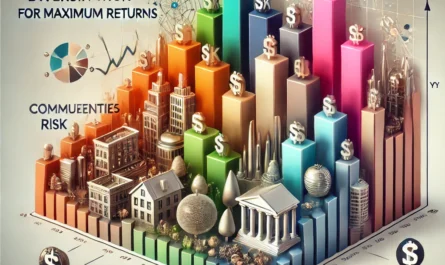Building a diversified investment portfolio is crucial for achieving financial stability and growth while minimizing risk. Diversification involves spreading your investments across different asset classes, industries, and geographical locations to mitigate the impact of market volatility. By doing this, you can safeguard against significant losses when one sector or asset underperforms.
A well-diversified portfolio not only provides a buffer during turbulent times but also enhances potential returns over the long term. Let’s explore the steps and strategies to create a balanced and diversified investment portfolio that suits your financial goals and risk tolerance.
Why Diversification Matters in Investments
In the investment world, the phrase “don’t put all your eggs in one basket” has never been more relevant. Diversification helps investors spread out the risks associated with holding a concentrated investment in a single stock, bond, or asset class. Without diversification, your portfolio becomes vulnerable to sharp losses when a particular market crashes or a single company performs poorly.
Additionally, by holding various types of assets, you increase your chances of benefiting from the growth in different market segments. For example, when stocks experience a downturn, bonds or commodities in your portfolio may still generate steady returns. Diversification is about finding the right balance that aligns with your financial objectives while managing risk.
Core Principles of Diversifying Your Portfolio
The foundation of a diversified portfolio lies in asset allocation, which refers to how your investments are distributed among different asset classes. The main asset classes include stocks, bonds, real estate, commodities, and cash. The allocation depends on factors such as age, risk tolerance, investment goals, and time horizon.
Younger investors might opt for a higher percentage of stocks due to their potential for higher returns, whereas those nearing retirement may prefer more bonds or stable assets to preserve capital. Achieving a balance between growth and stability is key to maintaining a well-rounded portfolio.
Stocks: Key Component of a Diversified Portfolio
When building a diversified portfolio, stocks are often the core asset class because of their potential for long-term growth. However, stock selection requires careful consideration. To diversify within stocks, you should invest in companies from various industries and market capitalization levels—small-cap, mid-cap, and large-cap.
Different sectors of the economy, such as technology, healthcare, and consumer goods, react differently to market conditions. By investing in companies across these industries, you can reduce the risk that comes with concentrating investments in a single sector. For example, when tech stocks slump, consumer goods or utilities might offer stable returns.
Bonds: Stability for Your Portfolio
Bonds are an essential component of a diversified portfolio because they typically provide stability during volatile market periods. Unlike stocks, bonds offer fixed returns, making them less risky. However, not all bonds are created equal.
Government bonds, such as U.S. Treasury securities, are considered one of the safest investments since they are backed by the government. Corporate bonds, on the other hand, offer higher returns but come with slightly more risk. Balancing between these two types can help maintain the stability of your investment portfolio without sacrificing too much potential return.
Real Estate Investment
Real estate has long been a favored asset class for investors looking for diversification. Investing in real estate can be done directly by purchasing property or indirectly through real estate investment trusts (REITs). REITs are popular because they allow you to invest in real estate without needing to buy or manage physical properties.
By including real estate in your portfolio, you gain exposure to an asset class that often behaves differently than stocks or bonds. This helps spread risk across sectors that aren’t always correlated.
Commodities as a Diversification Tool
Commodities such as gold, oil, and agricultural products can provide a hedge against inflation and market downturns. These tangible assets tend to perform well when inflation rises, as their prices generally increase during such times. Commodities are also uncorrelated with traditional asset classes like stocks and bonds, meaning they can move in the opposite direction when these assets decline, providing added protection.
Mutual Funds and ETFs for Easy Diversification
For investors looking for an easy way to diversify, mutual funds and exchange-traded funds (ETFs) are excellent choices. These funds pool money from multiple investors to purchase a variety of securities, offering built-in diversification. You can choose from funds that focus on specific sectors, geographical regions, or asset classes, allowing you to customize your level of diversification.
Global Diversification: Why It’s Crucial
Global diversification expands your portfolio beyond your home country, spreading investments across international markets. This is important because different regions of the world often experience economic cycles at different times. By holding investments in both developed markets (like the U.S. and Europe) and emerging markets (like China and Brazil), you reduce the risk associated with any single country’s economic performance.
Alternative Investments: Thinking Outside the Box
To truly diversify, consider including alternative investments in your portfolio. These may include cryptocurrencies, hedge funds, private equity, or venture capital. While these assets can offer high returns, they are often riskier and less liquid than traditional investments. Nonetheless, a small allocation to alternatives can increase portfolio diversity and growth potential.
Dollar-Cost Averaging in Building Your Portfolio
A useful strategy for building a diversified portfolio over time is dollar-cost averaging. This involves investing a fixed amount of money at regular intervals, regardless of market conditions. By doing so, you purchase more shares when prices are low and fewer when prices are high, thus reducing the average cost of your investments over time. This method lowers the risk of making a large investment at an inopportune time.
Diversifying Across Time: Long-Term vs Short-Term Investments
Balancing long-term and short-term investments is a key aspect of diversification. Long-term investments, such as stocks, provide growth potential over many years, while short-term investments, like bonds or cash equivalents, offer liquidity and stability. Having both in your portfolio ensures that you have access to funds in case of immediate needs, without sacrificing long-term growth.
Managing Risk with Diversification
A diversified portfolio is inherently designed to manage risk. However, the amount of risk you take on depends on your individual goals. Higher risk often leads to higher rewards, but it’s important to evaluate your risk tolerance before allocating too much to risky investments like high-growth stocks or cryptocurrencies. By balancing riskier assets with stable ones, you can protect your portfolio while still aiming for growth.
Rebalancing Your Portfolio
Over time, your asset allocation will shift as some investments outperform others. Rebalancing is the process of realigning your portfolio back to its original asset allocation. For example, if stocks have grown faster than bonds, you may need to sell some stocks and buy bonds to maintain the desired balance. Regular rebalancing, either annually or quarterly, helps ensure your portfolio stays aligned with your risk tolerance and investment goals.



